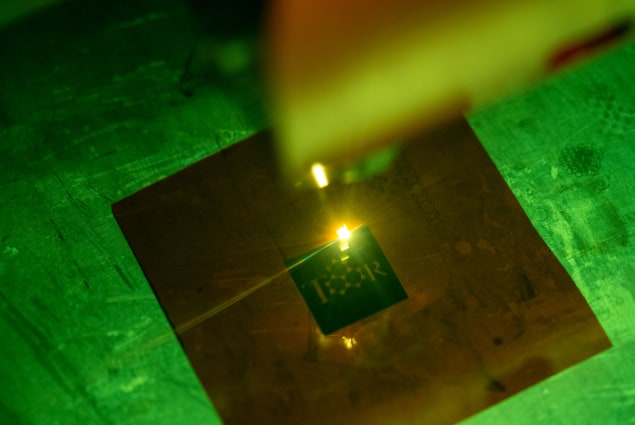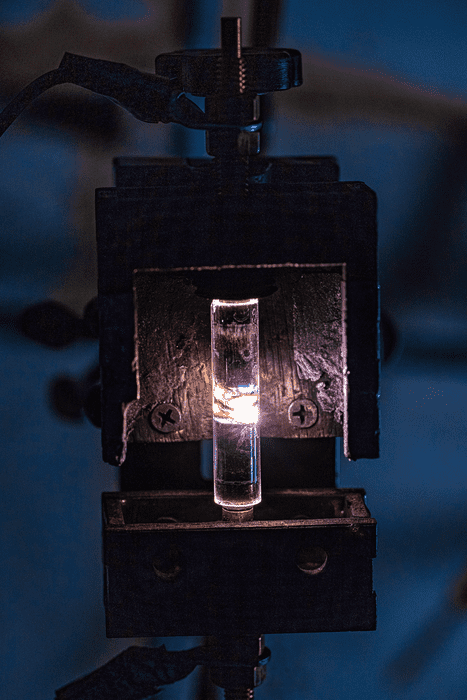Listening to graphene yields clues to its structure
17 Mar 2022 Isabelle Dumé

When scientists create graphene by heating a precursor material with a laser, they usually analyse the form and quality of the finished product using techniques such as Raman spectroscopy or electron microscopy. A team at Rice University in the US has now put forward a completely new alternative: listening to the sounds produced as this laser-induced graphene grows.
The new technique arose when two students in James Tour’s lab at Rice, John Li and Victor Li, got the idea of attaching a $31 microphone to the laser writing head. After recording the sounds the graphene made as it grew, the pair, who are brothers and were aged just 19 and 17 at the time, converted these sounds into spectrograms and used a simple signal processing technique known as a fast Fourier transform to turn the patterns into interpretable signals. Thanks to this technique, members of the team were able to analyse the properties of their laser-induced graphene in real time – a significant advantage over conventional methods.
Interconnected graphene sheets
Graphene is a two-dimensional form of carbon just one atom thick. In the laser-induced method of growing it, layers of interconnected graphene sheets form when a laser heats the surface of a thin polymer film to 2500 °C. The intense heat causes other components of the polymer to vaporize, leaving just the carbon atoms behind. Developed in 2014 by Tour and colleagues at Rice, the method can also be used to make graphene from other precursors, including food.
Normally, researchers assess the quality and morphology of this type of graphene by performing Raman spectroscopy and electron microscopy on it after the synthesis is complete. These measurements have low throughput, however, and they cannot be used to analyse the material in real time. They also only provide information about the relatively small area of the laser-induced graphene they sample, meaning that some products may escape detection.
Different sounds from different processes
The new sound-based technique, on the other hand, yields a real-time quality assessment of the entire graphene surface. To test it, the Rice researchers created laser-induced graphene by scribing an industrial polyimide film with a commercial 10.6-micron CO2 laser. As well as recording sound, they also used a camera to observe the formation of laser-induced graphene, which is associated with a visible blackening of the converted surface.
The different sounds they recorded come from different processes that occur during growth, explains John Li, who is now a PhD student at Stanford University (his brother Victor is now an undergraduate at the Massachusetts Institute of Technology). The sounds the graphene emits “provide information on the relaxation of the energy input when the laser hits the sample and gets absorbed, transmitted, scattered, reflected or just in general converted into different types of energy,” he says. Variations in these signals during synthesis, he adds, indicate that different products are being formed.READ MORE

The audio analysis technique gives the researchers a much greater ability to control the quality of the graphene as it forms. Members of the Rice team say that a similar method could be applied to other manufacturing processes, including plasma-spraying and cleaning, sintering, ball-milling, phase and strain engineering, chemical vapour deposition, combustion, annealing, quenching, laser-cutting and the flash Joule heating method also developed by Tour’s group.
The team, which reports its work in Advanced Functional Materials, now plans to explore ways of extending the acoustic analysis technique to some of these processes. “We also hope to develop new algorithms to analyse sounds and combine information obtained through sound with other techniques that provide complementary signals,” John Li tells Physics World.

Isabelle Dumé is a contributing editor to Physics World
FROM PHYSICSWORLD.COM 4/4/2022
Δεν υπάρχουν σχόλια:
Δημοσίευση σχολίου